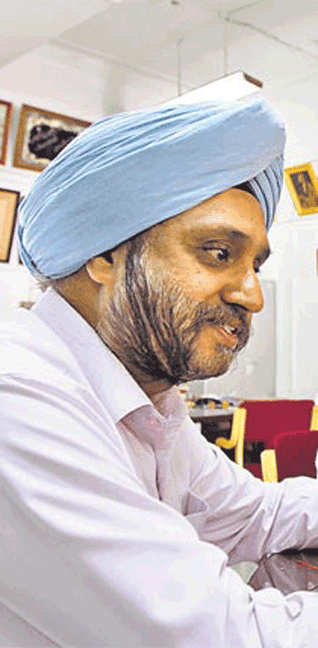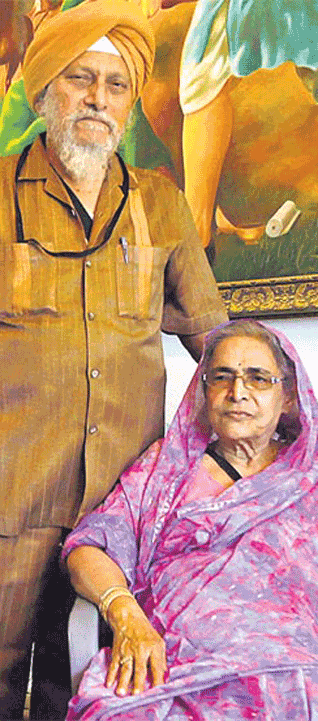
Below, 2nd from bottom: Sardar Nanak Singh Nishter and his wife. 3rd from bottom: Sardar Sajjan Singh.



Travel
The Deccani Sikhs of Telangana
PARAMITA GHOSH
During the past 10 years, Sajjan Singh, an engineer in Hyderabad, has been chasing the stories of his people, the Deccani Sikhs, and seen them disappear like rabbits down a hole.
Old reports commissioned by central or state minority commissions would cancel their own oral histories or only highlight part of it; new leads would pop up with the excavation of an ancient sword or a flintlock gun and be left hanging; a period-book would turn up at the Salarjung Museum in a script that he would have to learn to translate. And he would try to work out, as all minorities do, how best to have the history and culture of his community to not only be more widely known and spoken about by the community itself, but that it should ‘appear’ in the official history of Telangana at a time when the state is charting its own.
In the 100 days following the bifurcation of Andhra Pradesh, the Telangana government has been trying to redraw its priorities. A section of the population has interpreted the recently-conducted survey as one demanding proof of nativity.
[The new State of Telangana was created in India on June 2, 2014 by carving out the territory from the Hyderabad region of the existing State of Andhra Pradesh.]
The small but rooted 50,000-strong Deccani Sikh community has no such qualms. They say they are “natives”, people who settled in Hyderabad in 1832 as part of a gentleman’s agreement between two kings.
“This is our home and Telangana has always treated us as its own,” says Iqbal Singh, who runs a transport business, referring to their 200-old history of habitation at Barambala, the 600-acre area where the first Sikh regiment camped as it marched into Hyderabad from Lahore on Maharaja Ranjit Singh’s orders to help the fourth Nizam on the appeal of his prime minister, Chandu Lal.
Around 90% of Deccani (literally, southern) Sikhs are descendants of that army. At Barambala stands a school run by the Sikh Education Society and a gurdwara, one of the first constructed in the Deccan.
A rare lithographic copy of The Guru Granth Sahib of Lahore lineage is kept here.
Sajjan Singh’s interest in his own history, he says, began with this treasure as he helped in its binding and learnt to conserve it with the advice of Salarjung Museum experts.
What Deccani Sikhs now face is a peculiar situation. They are sandwiched between two identities:
a Their Deccani culture with historical links to the house of the Nizam, not a popular figure with India’s political elite due to his pro-Pakistan stand at the time of independence and hence under no obligation to honour his last orders; and
b The pressure of being Sikhs outside Punjab. Being a minority among minorities, they are also on no party’s agenda. Muslims constitute 18% of the minority population of Hyderabad, Christians are 7-9% while the Sikhs are just 1%. The dominant Muslim minority gets the cream of reservations. On the other hand, the propagation of the Sikhs’ social culture, leave alone religious culture, finds, if at all, intermittent political support.
In 2010, the Sikligar Sikh community (consisting primarily of ironsmiths) was included in the Backward Class (A) category; 285 houses were built for them, but they got no government job or financial assistance.
The encroachment by the Wakf Board of the 200-acre Barambala land (gifted by the Nizam, now a busy Hyderabad suburb) has meant the control of the community has dwindled to a mere 65 acres. They further allege that no government has tried reclaiming it on their behalf.
Sardar Ravinder Singh, the Karimnagar mayor, a Telangana Rashtra Samithi (TRS) man, is their sole ‘political force’. It’s a political appointment, they wish him well, but Deccani Sikhs expect nothing out of it.
There may also be a token Superintendent of Police here and an IAS there among the Deccani Sikhs, but most members of the community are self-employed. They run small-time businesses or are drivers working their own vehicles, or, are security guards at factories, reports a study by sociologist Birinder Pal Singh of the Punjab University, Patiala.
Deccani Sikhs are, thus unsurprisingly again, a mass of knotted longing and frustrations. In 2014, the creation of Telangana almost reminds them of the state of limbo that followed the annexation of the pricely state of Hyderabad into the union of India in 1948.
“We came flying 14 holy flags, we were a 14,000-strong army, we were led by Risaldars,” recites Baby Singh, a Class VII student at the Guru Nanak School, Barambala, at high pitch, as if she had just seen them charge past her school window.
The Sikhs aided in tax collection, spread the Nizam’s rule in his dominions and were, by all accounts, a good bouncers-cum-peacekeeping force.
“Unlike the British, the Sikhs didn’t come for war, or as refugees, we were invited,” says Yuvraj Singh, a young mechanical engineering student on the lookout for a job. “We came on horseback, we stayed on horseback.”
This 19th-century adventure story soured in its post-colonial encounter -- by 1950, the Nizam had entered the Governor’s house; his Sardars were getting out of their two-starred lapelled tunics and breeches into civvies, ready to leave the cantonment.
MIXED FEELINGS
All the talk of missed opportunities since 1950s also reflect the Deccani Sikhs’ other anxiety which many of them put in the language of demand. They are proud of being Deccani, but they also want an acknowledgement of their ‘cultural loss’ and a separation from latter-day Sikh migrants, the Sikh-Punjabis who settled in Telangana post-partition, or came here to escape the 1984 pogrom in New Delhi and other parts of India.
Sarjit Singh, a retired bank employee, the Sikh representative in the state minority commission (erstwhile Andhra Pradesh called it the Minority Finance Corporation), for example, says he is now an office-bearer without an office and a salary.
“100 days of the TRS government are over but the status of the body is ambiguous”, he says. “A Rs 10 billion/year fund is allotted for minorities but the breakup per community is unclear. I spent Rs 100,000 out of my own pocket to go on tours, visit gurdwaras in disturbed areas ... Who will give us compensation? We came here from Lahore and lost our culture, our practice of spoken (Punjabi) language.”
Deccani Sikh households speak a mix of Hindu-Urdu and are fluent in Telegu. Sajjan Singh’s wife, a bank official, even got a chance to be a Telegu news reader on TV.
The women wear bindis and saris, though the preference for salwar kameez has begun to catch on. The higher economic profile of the Sikh-Punjabis has triggered at the same time a protectiveness towards their own regional identity but also a watchfulness towards their upwardly mobile brethren from Punjab who are equally isolationist in their attitude.
Birinder Pal Singh’s study reveals that Hyderabad’s Pikh-Punjabis maintain a “hardbound glossy directory with complete contact details of their businesses” excluding the details about Deccani Sikhs and their businesses.
A group of young Deccani Sikhs list the following differences in all seriousness and state why these are reasons enough against intra-marriage:
“We follow a line, we are hardcore Sikhs. In Punjab, if they feel like dancing, they dance, they drink”;
“We never allow Sikhs with trimmed beards inside the gurdwara;”
“We may read the Guru Granth Sahib in Hindi and they might know Gurmukhi but we are more attached to the Sikh tenets”;
“Our food can’t do without imli; they make khatti dal in amchoor ...”
Their relationship with Punjab and mainstream Punjabi culture is, thus, complicated. They watch Punjabi films and TV serials but have no family there nor any special desire to relocate there.
(Only two students in a class in the Guru Nanak School said they have visited Punjab).
They acknowledge the importance of the Golden Temple but want to stay away from Shirmonani Gurudwara Prabandhak Committee (SGPC) politics.
“The SGPC tries to capture gurdwaras of Maharashtra and Hyderabad,” says a Deccani Sikh on the condition of anonymity. “They have a Rs 8 billion annual budget. But no funds for scholarship or grants for schools come our way.”
“We want reservation, we want Vaisakhi declared a state holiday,” says Kunal Singh, a bank employee. “Deccani Sikhs are cremated at Hindu cremation grounds. We want our own graveyard,” he adds when another young Sikh shuts him up with a cackle referring to a member of their community.
“That Darshan Singh Rajan, ever since he got a vehicle fitted with gurbani cassettes to take people to the funeral ghat, two people have been dying every week! No population to speak of and how we go on about having our own crematorium ...”
[Courtesy: Hindustan Times. Edited for sikhchic.com]
September 29, 2014
Conversation about this article
1: Sarvjit Singh (Massachusetts, USA), September 29, 2014, 4:08 PM.
Nice coverage of Deccani Sikhs but it is not complete if you don't include the Sikligar, Banjara, Gulbarga, Dhalbarga (now in Karnataka), Udgir, Nanded (now inMaharashtra), etc. When I lived there I had the opportunity of meeting and living with some of those Sikh families. It was fascinating to see Sikh women with saris, bindis ... and kirpans! These Banjara (nomad) Sikhs live in camps and stone houses near Latur, and still make kirpans as their ancestors did during Maharaja Ranjit Singh's time. It is sad that we have ignored such sister communities and it is equally sad that the Deccani Sikhs have lost the sense of entrepreneurship that their ancestors possessed.
2: Sunny Grewal (Abbotsford, British Columbia, Canada), September 29, 2014, 11:43 PM.
I'm surprised that this article did not mention the fact that during the protests for Telegana a Sikh gurdwara was attacked and the Guru Granth Sahib was looted. I think the incident speaks quite loudly about how the locals perceive the Sikhs, not as natives, but as foreigners. It is especially noteworthy as it was the only religious building in my knowledge that was attacked during the protests.
3: Hardarshan Singh Valia (Highland, California, USA), September 30, 2014, 10:35 AM.
A fine example of Sikhs adopting diverse environments, surmounting innumerable obstacles, thereby exemplifying the spirit of Chardi Kala! During my recent trip to Visakhapathnam, Andhra Pradesh, I was moved to see a Telugu raagi, Appa Rao, expressing gurbani on the tabla with an inspiring awe. When I asked him his mode of preparation for the recital, he showed me his handwritten sheet with shabads written in Telugu.
4: Sarvjit Singh (Massachusetts, USA), September 30, 2014, 3:17 PM.
Post #3: I have spent some time with those Deccani Sikhs and I felt sad, and did not see them as a 'fine example'. There are some exceptions but by far most of them live hovering around the poverty line and very subdued lives, contrary to what their ancestors were promised and enjoyed. They are a very proud people and still keshadhari but they have lost their connection with their roots. As opposed to Sikhs settled in UP or Bengal, they seem to be very subdued ... with some exceptions, of course.
5: Hardarshan Singh Valia (Highland, California, USA), October 01, 2014, 5:49 PM.
Post#4: My comments were in reference to the subjects mentioned in this article. While reading, I was touched by their attachment to the Sikh tenets. However, I fully realize that others, not described in the article, face insurmountable problems. I am hoping some one reading this article may provide the name of an organization that is working for the welfare of our brethren so that like-minded Sikhs can contribute funds.


